GALÁPAGOS CRUISE – NORTH AND WEST ISLANDS
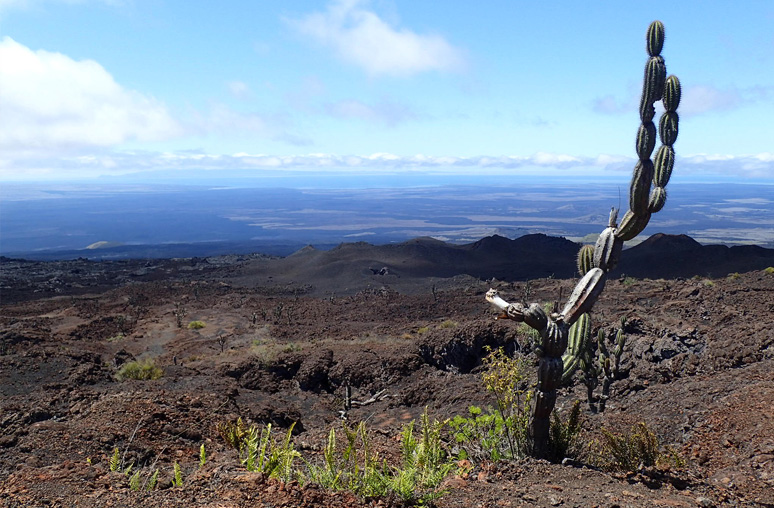
Galápagos Cruise – North And West Islands – 8 Days / 7 Nights
The best way to experience the mystical isolation of the Galápagos Islands is onboard the sturdy, stately and very comfortable motor-vessel.
Duration: 8 Days / 7 Nights
£3050 / $3950 per person
M/V Samba – A graceful 78–foot motor yacht of European vintage Tourist Superior Class
- The best way to experience the mystical isolation of the Galápagos Islands is onboard the sturdy, stately and very comfortable motor-vessel, the M/V SAMBA. A great ocean-going vessel with her specially designed high bow, she provides safe crossings and boasts a special stabilizing sail.
- Her main salon and dining facilities make her socially versatile while top-side settees and an ample forward deck provide a great space to relax in the sun or take part in group activities such as stargazing and whale watching.
- The SAMBA accommodates 14 guests, a perfect number to enjoy the magic of the Islands with privacy and flexibility. Its professional, experienced and friendly crew and naturalist guide are devoted to go the extra mile to make your journey a trip of a lifetime.
- Six air-conditioned double cabins and 1 exterior double bed cabin, all with private bathrooms and hot water.
Ask for details on combining the cruises for an extended 15 day / 14 night adventure and save on the price!
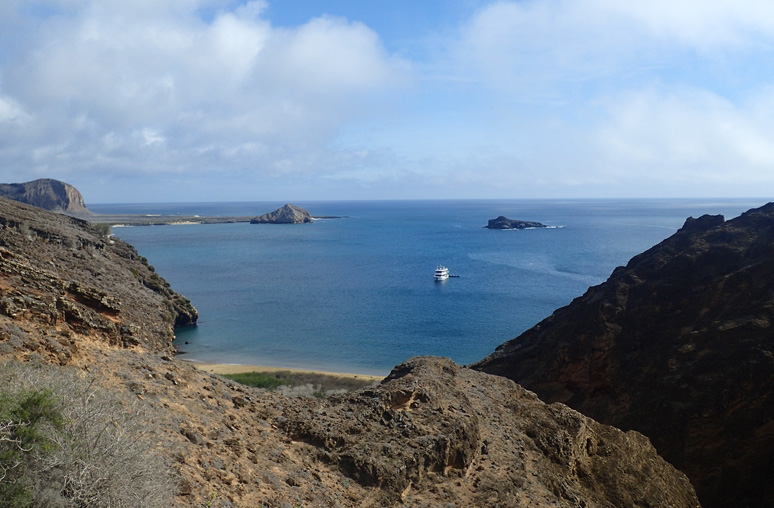
Tuesday
AM: Baltra Airport
PM: Mosquera
On arrival at Baltra Airport all visitors pay their entrance fee to the Galapagos National Park, pass through immigration control, claim their checked pieces and get their hand luggage checked by the Quarantine system. The Samba’s naturalist guide, Juan Manuel, will assist you with as you come out of the terminal and accompany on a short bus ride to the harbour to board the Samba.
After a light lunch the Samba will navigate for 45 minutes to Mosquera. Imagine a beach rising from the ocean floor in the middle of nowhere. Imagine sand grains as soft as sugar. Now imagine a sea lion colony and a fabulous sunset. You are here! Mosquera Islet is by far the best beginning of a Galápagos journey. This volcanic uplift that dates from 100 thousand years ago is a geological treasure for an admirable start. On the shore is easy to encounter Galápagos sea lions, sally light foot crabs and shore birds. Visitors are welcome to swim or snorkel from the beach.
Wednesday – Isla Genovesa (Tower)
AM: Darwin Bay
PM: Prince Philip’s Steps
After 6 to 7 hours of navigation from Santa Cruz you will wake up to the beautiful cacophony of one of the largest tropical sea bird colonies on the planet. The cliff tops are decorated with frigate birds, red-footed boobies, Nazca boobies, swallow tailed gulls, tropic birds and many other pelagic animals. Darwin Bay is the home of many nesting sea birds. Following a wet landing and with the early morning light you will blend in with the red-footed boobies displaying for potential mates as they collect nesting material. The great frigate birds inflate their gulag sacks hoping to attract a female while others play their favourite game: piracy. Darwin’s finches, Galapagos doves and mocking birds stroll the ground to find seeds and insects. The red mangroves, cactus and saltbushes contrast with the blue sky and the dark basaltic walls.
Following lunch there will be a dry landing to climb Prince Philip’s Steps. The steep ascent takes you 100 feet above sea level, to be welcomed by the elegant silhouette of red billed tropic birds and the aerobatic Galapágos shearwater, both interact with the precipice on fast approaches. The lava rock trail takes through the endemic dwarf incense tree forest, to find more red footed “lancers” nesting and many of their gannet like relatives, the Nazca, loudly claiming the floor as their residence. The Palo Santo forest is dormant most of the year, but awakens in the rainy season and fills the air with a refreshing aroma. As you leave, the latent trees the panorama of thousands of storm petrels flying erratically beyond the lava flows, will take your breath away. This is the perfect scenario for the island predator to make a successful kill. The short-eared owl, known elsewhere around the world as a nocturnal predator, on Genovesa hunts in bright daylight. More cat than owl, waits patiently outside lava tunnels and crevasses to capture the stormy petrels as they leave their houses after feeding their young.
Snorkeling on Genovesa offers a view of a wide variety of tropical fish.
Thursday – Isla Marchena (Bindloe)
AM: Punta Mejia
PM: Playa Negra
Usually boats will travel back south after sailing to Genovesa; the Samba is the only one heading west-northwest. The Galápagos National Park Service has granted us the chance to experience Marchena’s magical shoreline with snorkelling, a dinghy ride and kayaking. Bindloe’s serenity is only disturbed by the murmur and surge of the Pacific swells and the musical arguments of the castaway sea lions. Punta Mejía is one of the best sites in the Archipelago to snorkel. The calm and clear deep blue water of the north west coast, and the dark hostile topography of the location give the sensation of witnessing the beginning of our planet and its underwater world. Apart from great fish diversity, when we snorkel we often see rays, reef sharks and sea turtles.
Navigating southwest for 45 minutes to Playa Negra is always an exciting experience. More than once in the past we have seen bottle nosed dolphins, other cetaceans or feeding frenzies. After an early afternoon snorkel around recently formed lava grotto were marine iguanas feed, we will start a 5 to 6 hour sail to the west. As we get further away from the island the sea floor changes dramatically and we enter deep water, an oceanic drop-off. The Cromwell current, which arrives from the west from the very profound waters, brings richness to the surface and generates a superlative upwelling. As a result, there are positive effects throughout the marine food chain and we have a good record of cetaceans and other ocean wonderers on this navigation. Whales or dolphins are never guaranteed, but we will we do our best to find them.
Friday – Isla Isabela (Albemarle)
AM: Punta Albemarle
PM: Punta Vicente Roca
Human history has left its footprint on this small corner of the Galápagos. Punta Albemarle, the most northern point of Isabela, was once an important US radar station built to prevent the Japanese destroying the Panama Channel. Now a small and deteriorated building, it is a reminder of the boredom and routine that rusted the mind of the juvenile navy officers. The soldiers were in charge in three-week shifts where they never saw any action. Nevertheless, the wild life gives the best example of constant struggle for survival. The recent lava flows are the nesting ground of the only flightless cormorant in the world and the basking terrain of the largest iguanas of Galápagos. Because not many boats visit this site the cormorants, that are very shy birds, display as they built their bulky nest we seaweed with total indifference to human presence. As the morning advances the iguanas give a show of adaptation as they wonder on the shoreline to feed on green and red algae. With this fantastic setting you can only be reminded that the only constant of the Islands is change.
Punta Vicente Roca offers an overwhelming diversity of geological formations. Located on the southwest end of Ecuador Volcano only a few miles south of latitude 0, the area is an outstanding example on how the Islands were formed and how the forces of change have transformed the landscape and shaped the wildlife. Vicente Roca is the home of tuff cones and lava dikes and is fertile ground for erosion and the disaster of collapse. We will look at the dramatic structures from our dinghies, as we also enjoy watching the Galápagos penguins, brown noddies, blue-footed boobies and other marine life. When the waters are calm enough the snorkel is fascinating. The walls of the tuff cones are full of colourful invertebrates and rich algae blooming give us a great chance of watching numerous sea turtles feeding.
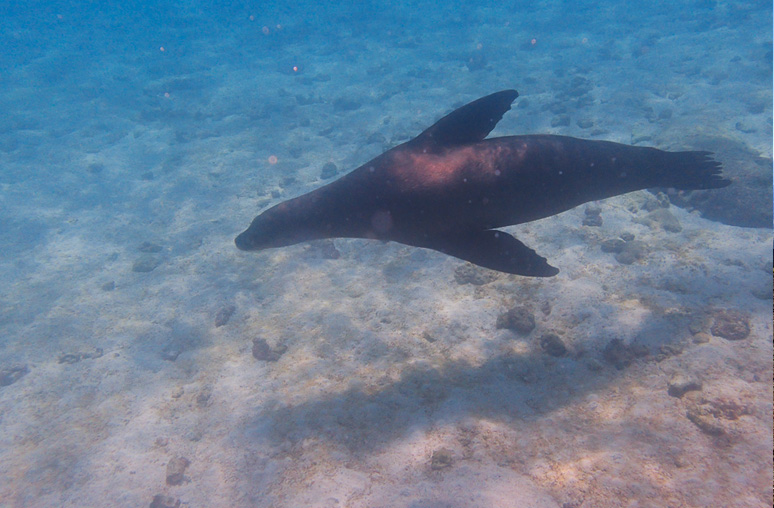
Saturday – Islas Fernandina And Isabela
AM: Punta Espinoza, Fernandina Island
PM: Urbina Bay, Isabela Island
Only 30,000-100,000 years old Fernandina is the youngest island of the Archipelago. This immature shield volcano is less than an instant in the geological time scale. Not even your wildest imagination can give you a better setting to experience the start of life on an island. The whole Island is cover with hostile worthless lava. However, at Punta Espinoza the shoreline is teeming with life. Reptiles, birds and mammals all coexisting, singing and sexing. It is a living museum with piles of marine iguanas, playful sea lions, hard working flightless cormorants, dwarf penguins, busy Sally light-foot crabs and much more. Don’t forget to look around because the Galápagos Hawk is always on the hunt. The site is a true cradle of evolution. Snorkelling with turtles, iguanas, cormorants and plenty of fish is the best way to refresh after the lava walk.
The hotspot under the Galápagos generates intense volcanic activity. The west islands are the youngest and most active of the Archipelago. Located in the centre of Isabela, Alcedo Volcano is remainder of how volatile this Islands are. On the west shore line of Alcedo lays Urbina Bay. The landmass of the inlet was uplifted in 1954. More than ¾ of a mile of shoreline were created, and many coral reef extensions where exposed to air as the upheaval rose the seabed. The brand new land became a perfect nesting terrain of the most beautiful land dragon. The land iguanas of Isabela are the largest in the Galápagos and in Urbina the colourful population offers a great example of their growing potential. The impressive yellow, orange/brown iguanas roam the low lands looking for flowers, fruits, leaves and shoots of their favourite plants. Also, when the rains arrive it is possible to see giant tortoises sharing the land with the other primitive looking reptile. Urbina is miniature reminder of a Jurassic time.
Sunday – Isla Isabela (Albermarle)
AM: Elizabeth Bay
PM: Punta Moreno
Isabela Island constitutes almost half of the entire surface of the Archipelago. It is nearly 100 miles long and offers a remarkable diversity of habitats. Shaped like a seahorse and with volcanoes over 5000 feet of altitude, it is also the place of birth of vast mangrove extensions. Elizabeth Bay is the only place of the Earth where old tropical mangrove forests and penguins can be conjugated on the same sentence. The ecosystem is also the residence of spotted eagle rays, sea turtles and a nursery for fish and marine invertebrates. With the outboards off and using only our oars for speed, we will enjoy this serene array of life.
When you land on Punta Moreno you understand why the Spanish Bishop that discover the Islands said: “It was as if God had decided to rain stones”. When he first set foot on a lava field he struggled to find fresh water and in desperation was reduced to chew on cactus pats to quench his thirst. More than three centuries later a young Naturalist saw beyond the lava. Charles Darwin was amazed by the colonization of plants and the start of life over this terrain. He thought this process could easily compare to the origin of life in our planet. The mystery of mysteries… The pioneer cactus growing over the country of lava is contrasted with stunning oasis. Where lava tunnel roofs have collapsed, brackish water accumulates to give life to greater flamingos, moorhens, black-necked stilts and Galápagos Martins.
Monday – Isla Floreana (Charles)
AM: Asilo De La Paz & Cerro Alieri
PM: Devils´Crown
After breakfast we land on Puerto Velasco Ibarra to ride on a ¨chiva¨(endemic transportation) to visit the highlands of Floreana. On the way to the humid zone we stop to climb Cerro Alieri. A good number of steps will take us to a breathtaking view. A fantastic landscape decorated with liquens and epiphytes. The mysteries of this Island are hidden in the pirates cave. At Asilo de Paz we will engage with the fascinating story of the Wittmers, Doctor Ritter and Dora, and the famous Baroness and her three lovers. Charles, Floreana and Santa María are the official names of the Island that holds an overwhelmingly rich human history.
In the afternoon we snorkel on one of the best sites in the world. It is a refreshing end to a wonderful trip. Around 3:00 pm we start to navigate to Puerto Ayora to arrive at Academy Bay for dinner.
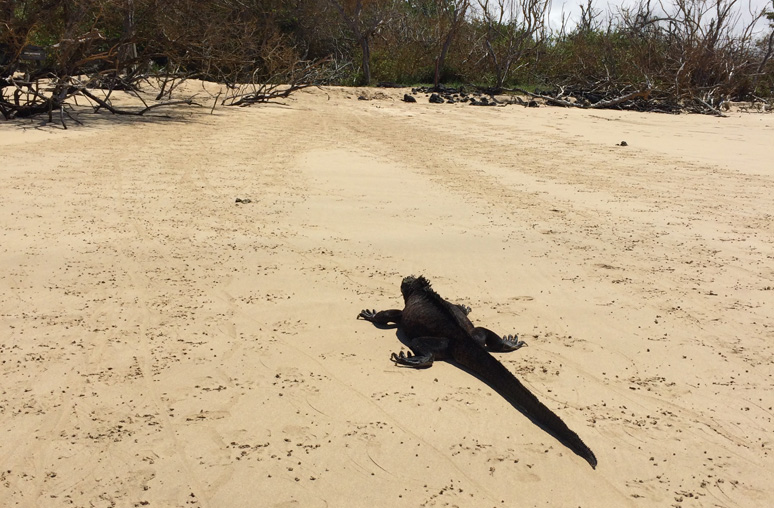
Tuesday– Isla Santa Cruz (Indefatigable)
AM: Highlands
PM: Check Out
After breakfast, at 07:30 we leave the Samba and embark on a bus to travel through the Island. You will stop at the Highlands of Santa Cruz. At 1800 feet the greenery offers the opportunity to admire the remnant of a Galápagos mature forest. The Daisy trees of the genus Scalesia decorate a couple of extraordinary geological formations. Known as “Los Gemelos”, this collapse craters and its surroundings are the home of many Darwin’s finches, mocking birds and a wonderful diversity of indigenous plants. It is strongly recommended to wear appropriate gear for this visit to the Highlands. Because the area is under constant influence of moisture is likely to be muddy and humid. We will arrive to the airport around 11:00. Breakfast and airport transfer included.
ADDITIONAL INFORMATION ABOUT THE TOUR
BEFORE THE DISCOVERIES
The naturalist guide gives briefings every evening after or before dinner. He will give you information about the activities of the following day. The briefing is designed to prepare you for your visit, you will learn the times of disembarking, guidelines of what to bring to the activities, terrain and weather conditions, as well as the animals and plants you will be able to see.
DO NOT FORGET
In preparation for our daily excursions, please make sure you carry the following items:
Comfortable and informal clothing such as shorts, light pants, cotton t-shirts, sweaters and windbreakers, according the season of the year.
- Cap or hat
- Sunglasses (polarized always better)
- Insect repellent
- Sun Screen
- Water bottle
- Appropriate walking gear (Good walking shoes/walking sandals/walking poles)
- Cameras, batteries and memory cards
When you return to the Samba please make sure to leave your excursion shoes at the stern. Use other sandals or comfortable shoes for walking in all outside areas of the Yacht. This will help prevent carrying alien microorganisms from island to island. Shoes are not allowed inside. For more information about gear check the Packing Guide suggestions.
SAFETY
To have a pleasant journey we have made your safety our number one priority. The boat has approved strong national and international regulations to prevent and respond on any emergency scenario. All crewmembers are trained to assist you in case of any emergency. As a mandatory regulation you will be part of a safety drill exercise in order to know what to do in case an emergency occurs. Your naturalist guide will instruct you with safety procedures.
Please make yourself familiar with the location of the life vests and fire extinguisher in your cabin, as well as the quickest way to get to safety. Should you have any questions, please approach our naturalist or Captain.
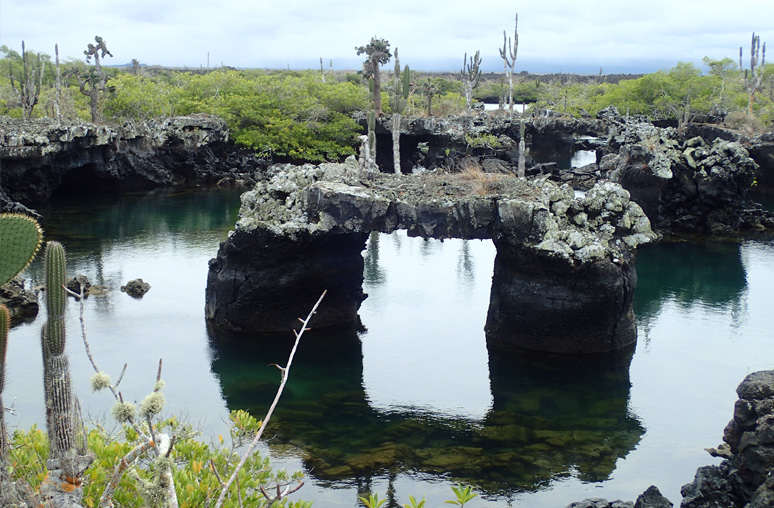
SNORKELING SESSIONS AND OUR GEAR
The water in the Galápagos is quite cool considering the archipelago straddles the Equator. The cold Humboldt current flowing north from Antarctica and northwest from South America account both for this cold water and the productivity of the islands.
Snorkelling is highly suggested to get a vision of the underwater world. To relax and refresh you will often have the opportunity to swim and/or snorkel after or before the landings on most days.
The snorkelling equipment on board is included on the price of your trip. Our gear is of excellent quality. The masks, snorkel, wet suits and fins are in excellent conditions. We ask you kindly to take good care of all the gadgets provided on the Samba. We supply 3mm full-length suit is essential for all but the most warm-blooded of us, giving better protection from cold, sunburn, rocks, and the occasional jellyfish.
Any damage or loss of the equipment will be billed to you at the end of the cruise at the following rates:
Mask: USD 50.00
Fins: USD 55.00
Snorkel: USD 40.00
Wet suit: USD 150.00
We regard damage as the impossibility of reutilizing the equipment again. Normal wear and tear is not considered damage. We appreciate your understanding and rely on your best intentions.
SMOKING ON BOARD
It is not allowed to smoke on land or at any National Park areas. On board the Samba smoking is only allowed outside on the stern deck. The crew will be willing to provide you with an ashtray.
AIR CONDITIONING
An individual A/C works in each of our cabins. Please ask the guide or one of the crewmembers about its use.
WATER
Potable drinking water is provided on board. We produce it with a reverse osmosis plant making it very safe to drink. All fresh goods and meals are washed and cooked with the water that we produce.
We strongly discourage buying bottled water, since it is our mayor goal to reduce the amount of plastic waste produced while in Galapagos we ask you kindly to reuse the plastic bottle given to you on the first day. This bottle can be refilled with fresh water from the dispenser placed in the lounge. If you can bring your own refillable bottles is best!
Be smart with the use of water. It is of great help if you take short showers and reduce the overall energy necessary to produce water on board. A simple effort from you might mean a great contribution…
Be kind to use your bath towel more than once. Please make this decision: Hanging your towels back on the holders tells us: “I will use them once more”. If you leave them on the floor we understand that you need them to be changed.
ELECTRICITY SUPPLY
The Samba has electricity outlets of 110 and 220 volts on every cabin. Extra electricity outlets are found at the dining room.
TOILETS
Keep in mind that yacht plumbing is different from what you have at home. We will explain the correct operation of your toilet. Because we treat our wastewater remember not to throw any toilet paper, sanitary napkins, plastic, etc, into the toilets and use the waste bin to dispose of bathroom waste only. Our crew will clean that trashcan every day. Do not forget to close the valve after flushing the toilet. Thank you!
CABIN SERVICE
Your room will be ready when you return from the morning excursion. If you need towels to go ashore, the crew will be pleased to provide them.
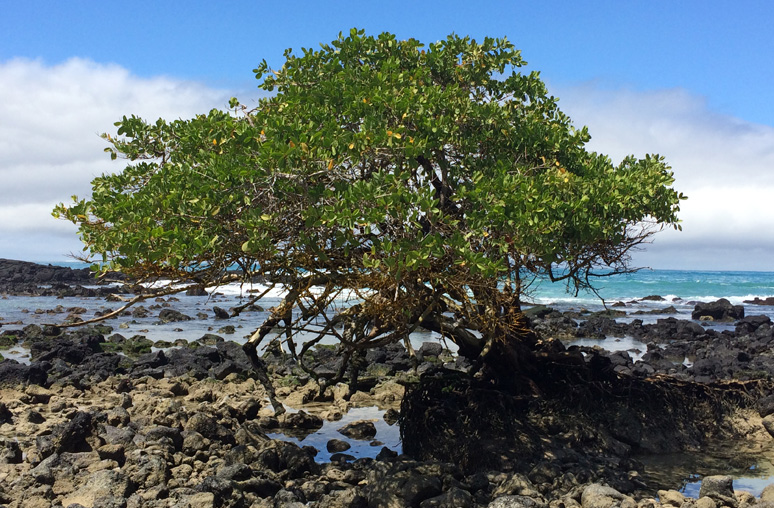
MEALS AND DINNING SERVICES
We serve the best food in the Archipelago! Most of our goods are fresh, locally grown and organic. Our chef offers fine cuisine ranging from international to local specialties that are served in our dining room. Please let our chef know if you have any restrictions concerning your diet, so we may serve you the best we can. The regular schedule for meal service is the following:
Breakfast – It could be as early as 05:00 and as late as 08: 30.
Lunch – This meal will normally be served between 11:30-13:30.
Dinner – We usually provide service somewhere between 18:30-20:00.
Snacks are served twice a day.
Times of the meals are flexible and may vary to meet nature at its best!!
LOUNGE SERVICES
We offer a variety of table games, videos, books and other Galápagos related information in the main lounge for your enjoyment. Be sure to return the books you borrowed to the shelf at the end of your cruise. Returning them will offer enjoyment to passengers arriving after you.
BAR SERVICE
The alcoholic drinks and sodas are the only items that are not considered in your trip voucher. Our staff will provide a bar card to keep track of what you drink during the voyage. In the fridge you will find a variety soft drinks, beer and wine. The barman will prepare cocktails and other liquors on upon request.
Prices on board are competitive enough that you do not need to bring liquor to the ship.
COMMUNICATION
The yacht is equipped with two UHF/VHF/Motorola radios, satellite and a cellular phone. The satellite phone on board can be contacted by dialling (008) 7077 318-0983. Guests can use the SAT phone on board at $5 per minute to call out. Internationally enabled cell phones should get reception some places in the Galápagos. Communication with the coast guard and office in Puerto Ayora is possible at any time.
PAYMENTS
Your purchases will be kept on record on your bar card and tallied at the end of your voyage. Your account must be settled prior to disembarkation in cash. We do not take credit cards only American dollars are accepted.
TIPPING & GRATUITIES
Tipping is a frequently asked question by our guests. We understand that this is a very sensitive issue, since tipping is a voluntary gift given by you in recognition to the service provided by our crew. If you are happy with the service provided and based on past experiences on board the average tip for the entire crew, except the guide, has been of USD 200 per person for a one week cruise (this amount will be divided amongst the crew equally).
For the naturalist guide the average tip has been of USD 100 per person for a one week cruise. Please remember that this is a mere suggestion as tipping is a very personal gesture. You may wish to use two envelopes, one for tips for the crew and the other for the naturalist guide. Gratuities can be handed personally or as a group.
CHECK OUT
Please make sure to do most of your packing the night before leaving the Samba. Since we do an early morning landing on the date of departure and the check out is after breakfast, you will have very little time to pack before leaving the Samba.
HEALTH AND MEDICAL
No immunizations are required and malaria pills are not needed on this itinerary. In the Galápagos, the water onboard is desalinated and very safe to drink. On mainland Ecuador, we recommend drinking bottled water.
In the Galápagos, use plenty of sunscreen, wear a hat, polarized sunglasses (to have a better filter to see through water) and bring good boots or walking shoes for walking on lava.
Bring an adequate supply of any medications you take regularly or might need; nothing will be available in the Galápagos. Seasickness is not a large problem in the Galápagos as we are near the islands most of the time and the seas tend to be calm. Nearly all of the open sea passages, when the boat could rock a bit more, will be at night. If you do experience motion sickness, you should bring medication or other preventative measures (electronic “Relief bands” seem to work well also). Please feel free to contact us for recommendations. Eating well, avoiding excessive amounts of alcohol, and getting a good night sleep are also key in preventing an over-active stomach. Please be sure you have listed any medical problems, special dietary requests, food allergies, or food preferences on your and update us if there are changes before the trip.
INSECTS
Insects are not usually a problem in the Galápagos, though there are wasps at a few landing sites. Please let us know if you are allergic to stings. In general, use insect repellent if you use it at home on field outings in the summer. Mosquitoes are not generally a problem even on the mainland, but if travelling in the rainy season there will be mosquito activity in some locations in the Galápagos, especially early morning and late afternoon. Long, lightweight cotton or nylon pants are the most practical for protection from sun, scratchy bushes along the trails, and insects.
WALKING AND TRAIL CONDITIONS
Galápagos walks vary from short to a couple of miles long over broken and uneven terrain. If you are not accustomed to walking distances, especially over rocky and uneven terrain, you will still be able to join in most activities as we travel at a pace that allows us to see, appreciate and photograph the unique nature of the Galápagos. There are some basic walking sticks onboard that you can borrow or you may prefer to pack your own for stability on rocky terrain (stepping up and down over large rocks). If you anticipate struggling with the walks, we strongly urge that you get out and do some good forest walking and hiking beforehand to get yourself in good condition for the trip. The more fit you are when the trip begins, the more you will enjoy your time in the field!
IMPORTANT PACKING NOTE
Please carry any essential items, such as travel documents and prescription drugs, plus fragile items such as cameras and binoculars, aboard the plane in your carry-on luggage. You may also wish to include in your carry-on a change of clothing, toiletries, in case of the regrettable lost baggage syndrome. Airline restrictions can change frequently so we recommend that you check the website for the airline you will be flying shortly before your departure to get their most up-to-date luggage restrictions.
ADDITIONAL INFORMATION ABOUT THE M/V SAMBA
Equipment
Very efficient Twin DAV diesel engines 280 HP-CUMMINS that only use a remarkable 6 gallons of diesel every hour! Two generators each of 21 & 12.5 kW for 110 V & 220V A/C and 12V & 24V D/C, Furuno Navnet Radar, Plotter and Sonar, GPS, VHF & SSB radios, two tenders with outboard motors, 32’ High Definition LCD TV, DVD video equipment.
Specifications
Length: L.O.A.* 78 feet / 23 meters
Beam: 18 feet / 5.4 meters
Tonnage: 134 tons
Speed: 8.5 knots
Range: 2.500 miles
Sails: Genoa, main, mizzen
Water capacity: 1.500 gallons and water maker
Electric Power Supply: 110V & 220V (A/C)
*L.O.A.: length overall
Equipment:
Very efficient Twin diesel engines 280 HP-CUMMINS that only use a remarkable 6 gallons of diesel every hour! Two generators each of 21 & 12.5 kW for 110 V & 220V A/C and 12V & 24V D/C, Furuno Navnet Radar, Plotter and Sonar, GPS, VHF & SSB radios, two tenders with outboard motors, 32’ High Definition LCD TV, DVD video equipment.
Safety equipment:
One self-contained 20-passenger life raft, EPIRB (Emergency Positioning Indicating Radio Beacon), two bi-directional VHF emergency-radios, one VHF (Motorola) wide-range radio, VHF and HF radios and one cell-phone and a Satellite phone communication system, life jackets, fire extinguishers, safety smoke and fire detectors and overhead sprinkler systems, A.B.C fire-control system and CO2 bank for the engine room.

